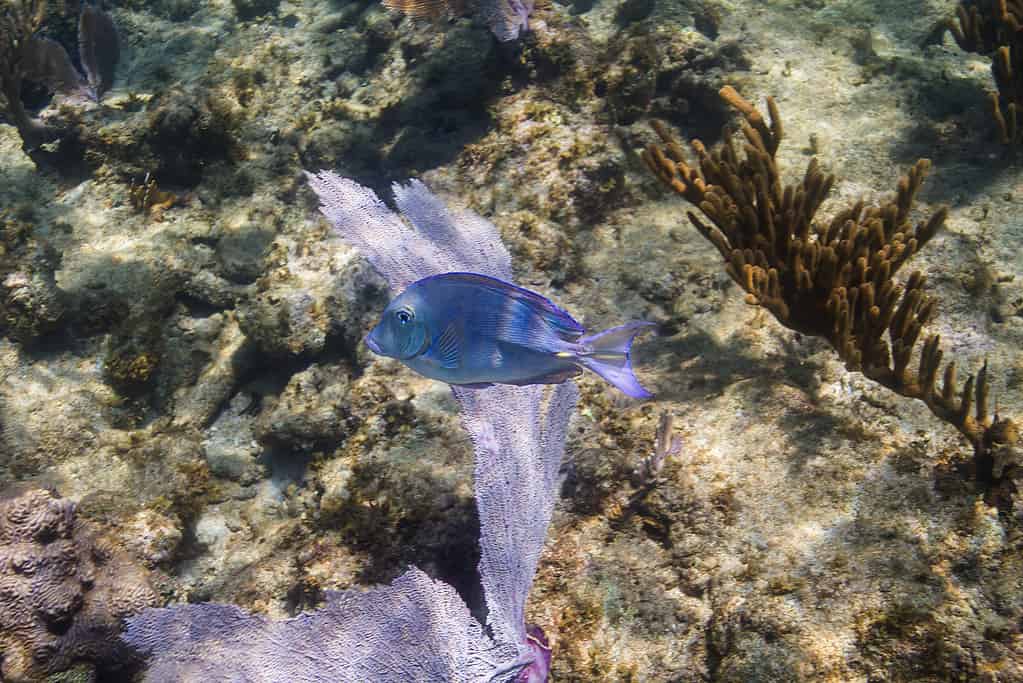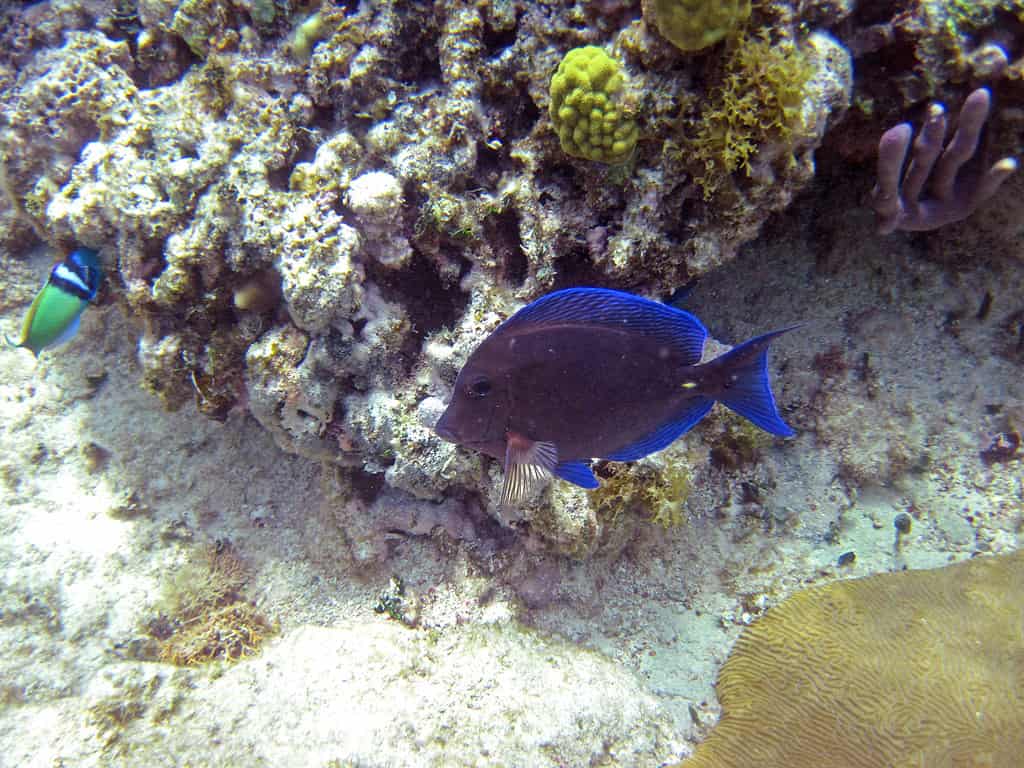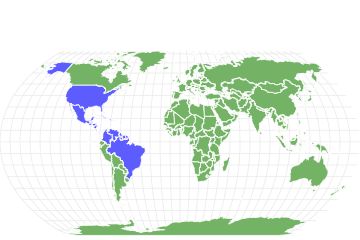The blue tang has caudal spines that resemble a surgeon's scalpel!
Advertisement
Blue Tang Scientific Classification
- Kingdom
- Animalia
- Phylum
- Chordata
- Class
- Actinopterygii
- Order
- Acanthuriformes
- Family
- Acanthuridae
- Genus
- Acanthurus
- Scientific Name
- Acanthurus coeruleus
Read our Complete Guide to Classification of Animals.
Blue Tang Conservation Status
Blue Tang Facts
- Name Of Young
- Fry
- Group Behavior
- Solitary/School
- Pair
- Fun Fact
- The blue tang has caudal spines that resemble a surgeon's scalpel!
- Most Distinctive Feature
- Caudal spines
- Other Name(s)
- Blue tang surgeonfish, Atlantic blue tang, blue doctor, yellow doctor, blue barber, yellow barber, blue doctorfish
- Predators
- Reef sharks, large carnivorous fish like tuna, tiger groupers, bar jacks, snappers
- Lifestyle
- Diurnal
- Common Name
- Atlantic blue tang
- Number Of Species
- 1
- Slogan
- One of the most colorful members of the genus Acanthurus
- Group
- School
Blue Tang Physical Characteristics
- Color
- Yellow
- Blue
- Skin Type
- Scales
- Venomous
- No
- Aggression
- Medium
View all of the Blue Tang images!
The blue tang is a species of surgeonfish mainly inhabiting the western Atlantic Ocean. This reef-associated fish tends to be elusive, keeping itself hidden from predators whenever possible. When necessary, it uses the retractable spines near its tail for defense. Humans should be cautious when handling these fish as their spines can cause serious injury. This species’ commercial value is limited due to its unsuitability as a food fish, though it is useful both as bait and as an aquarium fish.
4 Blue Tang Facts
- A type of surgeonfish: Surgeonfish have one or more sharp spines near their tails in the approximate shape of a surgeon’s scalpel. These spines are capable of causing deep cuts. Some of them are retractable while others are fixed.
- Elusive: Being small in size, this fish constantly needs to evade predators. It likes to hide itself in holes in the coral where it lives, especially at night. It can be difficult to spot even during the day.
- Three different color phases: These fish go through three distinct color phases according to how old they are, beginning with bright yellow and eventually transitioning to a deep blue.
- Aquarium fish: Due to its eye-catching coloration, this species makes a desirable aquarium fish. However, pet owners must be prepared to accommodate its needs, including giving it ample space to swim.
Blue Tang Classification and Scientific Name
The blue tang (Acanthurus coeruleus) is a marine fish species belonging to the genus Acanthurus. The name comes from the Greek words for thorn (akantha) and tail (oura) and refers to the bladelike spine found at the base of the tail. Alternate names for this fish include blue tang surgeonfish, Atlantic blue tang, blue doctor, yellow doctor, blue barber, yellow barber, and blue doctorfish.
The genus Acanthurus has 41 species that range throughout the Atlantic, Pacific, and Indian Oceans. Its family, Acanthuridae, contains over 80 species in six genera and includes surgeonfishes, tangs, and unicornfishes. This family belongs to the order Acanthuriformes (surgeonfishes) and the class Actinopterygii (ray-finned fishes).
The species Acanthurus coeruleus should not be confused with a similar type of surgeonfish, Paracanthurus hepatus. This Indo-Pacific species may also go by the name “blue tang.”

The blue tang
(Acanthurus coeruleus)has a bladelike spine at the base of its tail.
©iStock.com/yannp
Blue Tang Appearance
The blue tang is a laterally compressed, deep-bodied fish with three distinct color phrases. In the first phase, juveniles begin life as bright yellow fish with blue-edged fins; their bodies transition at some point to a mixture of blue and yellow. During the second phase, they take on a pastel blue or purplish-gray hue with yellow in the caudal fin. In the third phase, adults of this species take on their signature deep blue coloration, which may contain a hint of purple, with a yellow caudal spine.
These fish are frequent grazers with 14 teeth on the upper jaw and 16 on the lower jaw adapted for eating algae. Their small mouths sit near the bottom of their heads while their eyes sit higher up. Like many other surgeonfish, this species has retractable spines on either side of the caudal peduncle (the narrowest part of the tail). Because of this adaptation, it is dangerous to handle.
Adults of this species typically measure between 9.8 and 12 inches in length, though they may grow as long as 15.3 inches (1.3 feet).

Atlantic blue tang adults take on their signature deep blue coloration, which may contain a hint of purple, with a yellow caudal spine.
©iStock.com/pclark2
Blue Tang Distribution, Population, and Habitat
The blue tang ranges along the coasts of a number of countries and islands in the western Atlantic Ocean from New York in the United States to Brazil. Its range includes Bermuda, the Gulf of Mexico, and Ascension Island in the eastern Atlantic. Within the United States, it occurs along the coasts of New York, New Jersey, Delaware, Maryland, Virginia, North Carolina, South Carolina, Georgia, Florida, Alabama, Mississippi, Louisiana, and Texas.
The blue tang is a reef-associated marine species occurring at depths between 6.5 and 164 feet. A mainly diurnal species, it prefers inshore regions with coral, grass, or rocks where it can hide from predators at night. Although some individuals are solitary, many live in pairs or small schools, occasionally forming larger groups with similar species.
Below is a table of the countries, islands, and regions with populations of this fish.
| North America | South America | Africa | Europe |
|---|---|---|---|
| Anguilla | Aruba | Saint Helena | Ascension Island |
| Antigua and Barbuda | Bonaire | ||
| Bahamas | Brazil | ||
| Barbados | Colombia | ||
| Belize | French Guiana | ||
| Bermuda | Guyana | ||
| Cayman Islands | Suriname | ||
| Costa Rica | Venezuela | ||
| Cuba | |||
| Curaçao | |||
| Dominica | |||
| Dominican Republic | |||
| Grenada | |||
| Guadeloupe | |||
| Guatemala | |||
| Haiti | |||
| Honduras | |||
| Jamaica | |||
| Martinique | |||
| Mexico | |||
| Montserrat | |||
| Nicaragua | |||
| Panama | |||
| Puerto Rico | |||
| Saint Kitts and Nevis | |||
| Saint Lucia | |||
| Saint Martin (French) | |||
| Saint Vincent and the Grenadines | |||
| Sint Maarten (Dutch) | |||
| Trinidad and Tobago | |||
| Turks and Caicos Islands | |||
| United States | |||
| Virgin Islands (UK) | |||
| Virgin Islands (US) |
As of 2010, the IUCN lists this as a species of Least Concern. Its populations worldwide are currently stable.
Blue Tang Evolution and History
The blue tang most likely had its roots in the early Eocene Epoch (56 to 33.9 million years ago) during the Paleogene Period. The name Eocene comes from the Greek word eos, meaning “dawn.” This reflects the development and diversification of many modern species during this time. The modern genus Acanthurus began to emerge in this epoch, eventually producing the 41 extant species we know today.
The deep body and the low-level mouth of the blue tang likely began to evolve in a common ancestor of the genus Prionurus and the subfamily Acanthurinae. Similarly, the ancestor of the acanthurins produced a longer snout, smaller eyes, and a long intestine. Within the family Acanthuridae, the zooplanktivores in the genera Acanthurus and Paracanthurus had a different morphological background than those of the related genus Naso (unicornfishes).
Phylogenetic studies on the genus Acanthurus reveal that three Atlantic species within it, namely A. coeruleus (the blue tang), Acanthurus chirurgus, and Acanthurus bahianus, do not show significant diversity despite their geographic separation. However, populations of A. coeruleus from the southwestern Atlantic and the Greater Caribbean showed divergences in the number of rDNA sites. This is possibly due to the intervening outflows of the Amazonas and Orinoco rivers.
Blue Tang Predators and Prey
The blue tang devotes itself to eating during the day, grazing extensively among rocks and coral. It hides from its many predators at night using holes and crevices in its home reef.

The Atlantic blue tang exclusively eats algae from their home reefs.
©James St. John / Flickr – License
What Does the Blue Tang Eat?
These fish are herbivores, exclusively eating algae from the reefs they call home. Along with similar species, including other surgeonfish, they help keep the growth of algae in check to prevent it from damaging the coral.
Juveniles also participate in picking molted skin and parasites off the skin and carapaces of green sea turtles (Chelonia mydas) with a special focus on the flippers. They do this in conjunction with the doctorfish (Acanthurus chirurgus) and the sergeant major (Abudefduf saxatilis) in the southwestern Atlantic.
What Eats the Blue Tang?
These relatively small fish are the targets of predators like tunas, tiger groupers, bar jacks, snappers, and various other large fish. Reef sharks also pose a threat.
Blue Tang Reproduction and Lifespan
Blue tangs usually only spawn once or twice a year. Prior to spawning, sexually mature fish change from a uniform blue to pale blue with a darker blue posterior. They gather in large aggregations in the late afternoon and evening, whereupon several breeding females and males separate themselves from the larger group. Males aggressively chase females, which results in a “spawning rush,” a dash toward the surface of the water. During this activity, both sexes release their sperm and eggs into the water.
The eggs are approximately 0.03 inches in diameter. A drop of oil in each egg enables it to float in the water. Fertilized eggs hatch within 24 hours, releasing translucent larvae with rudimentary caudal spines. These larvae go by the name “acronurus” due to previous misconceptions that they belonged to a separate genus, Acronurus. These laterally compressed larvae are diamond-shaped with triangular heads and large eyes. They also have vertical body ridges and pectoral fins.
By the time the larvae reach 0.07 to 0.24 inches in length, they have developed scales and anal and dorsal fins. At lengths of 0.5 inches, their caudal spines are developed. The fry drift inshore, transitioning into the juvenile stage. Associated changes include a color shift from silver to brown, longer snouts, and a rounder profile. After about a week, they attain two inches in length and their color shifts again to bright yellow.
Fish of this species attain sexual maturity at nine to 12 months of age, which corresponds to lengths of around four to five inches. They live as long as 12 to 15 years in the wild.
Blue Tang in Fishing and Cooking
The blue tang is of limited commercial value as a food fish due to the unpleasant smell of its flesh. It also occasionally causes ciguatera poisoning. Fishers sometimes use these fish as bait, though they are more often useful in the aquarium trade. Potential pet owners should be aware that these fish require an intermediate level of expertise. For more information on how to care for these fish, see this guide.
Related Animals:
View all 285 animals that start with BBlue Tang FAQs (Frequently Asked Questions)
Where is the blue tang found?
This species ranges throughout the western Atlantic Ocean from New York in the United States to Brazil. It also occurs near Ascension Island in the eastern Atlantic.
Is the blue tang good to eat?
These fish are not generally good for eating due to their pungent flesh and the potential for ciguatera poisoning.
Is the blue tang a good aquarium fish?
This species is a common aquarium fish, though they require ample space and an intermediate level of expertise.
Is the blue tang an endangered species?
These fish are not endangered. As of 2010, the IUCN lists them as of Least Concern.
Thank you for reading! Have some feedback for us? Contact the AZ Animals editorial team.
Sources
- Fish Base, Available here: https://www.fishbase.se/summary/944
- Lamar University, Available here: https://www.lamar.edu/arts-sciences/biology/study-abroad-belize/marine-critters/marine-critters-2/the-blue-tang-surgeonfish.html
- Florida Museum, Available here: https://www.floridamuseum.ufl.edu/discover-fish/species-profiles/acanthurus-coeruleus
- Who Gives a Fish, Available here: https://www.whogivesafish.com/atlantic-blue-tang
- IUCN Red List, Available here: https://www.iucnredlist.org/species/177953/1501275
- Britannica, Available here: https://www.britannica.com/animal/surgeonfish
- ScienceDirect, Available here: https://www.sciencedirect.com/topics/agricultural-and-biological-sciences/acanthurus

















